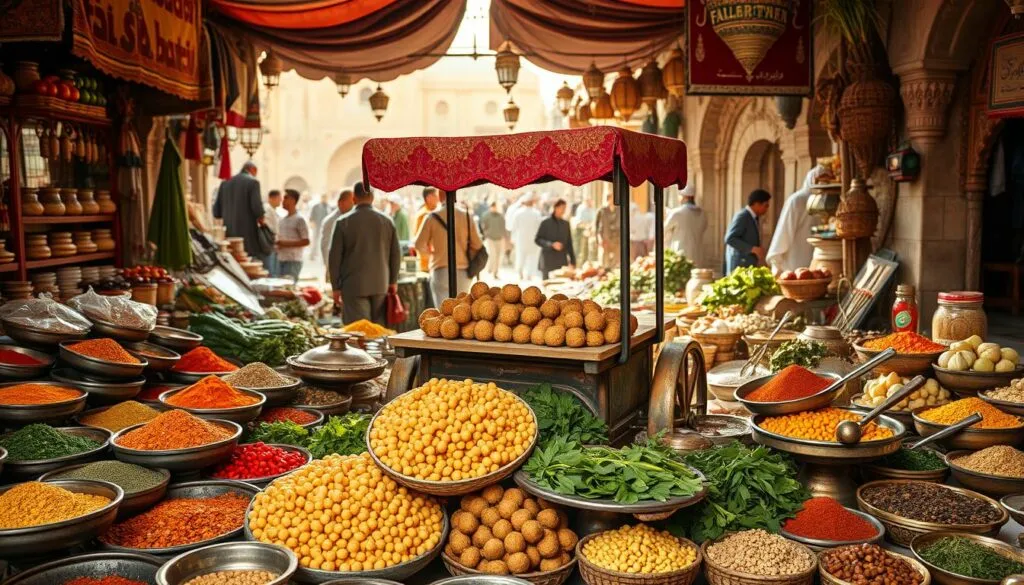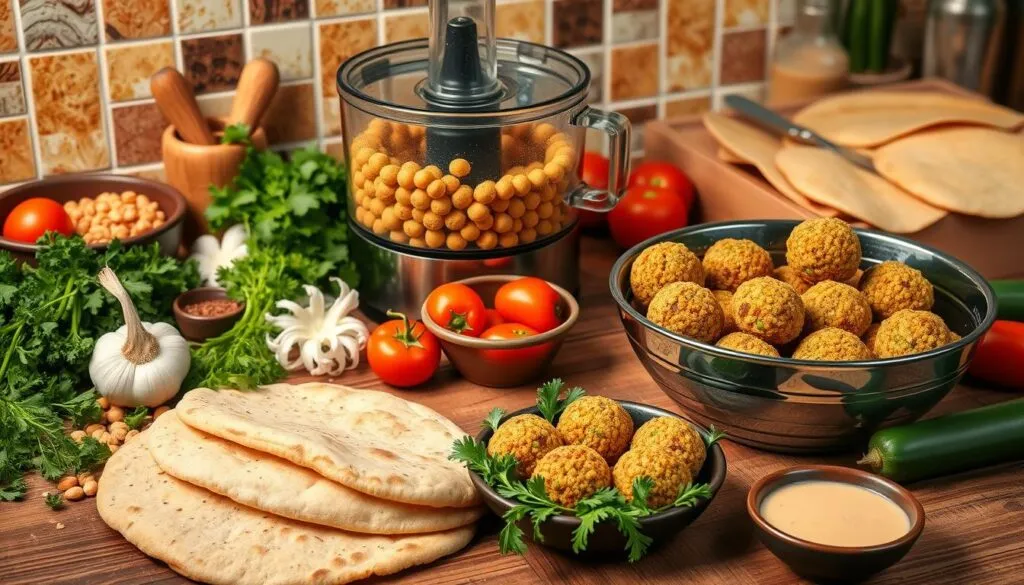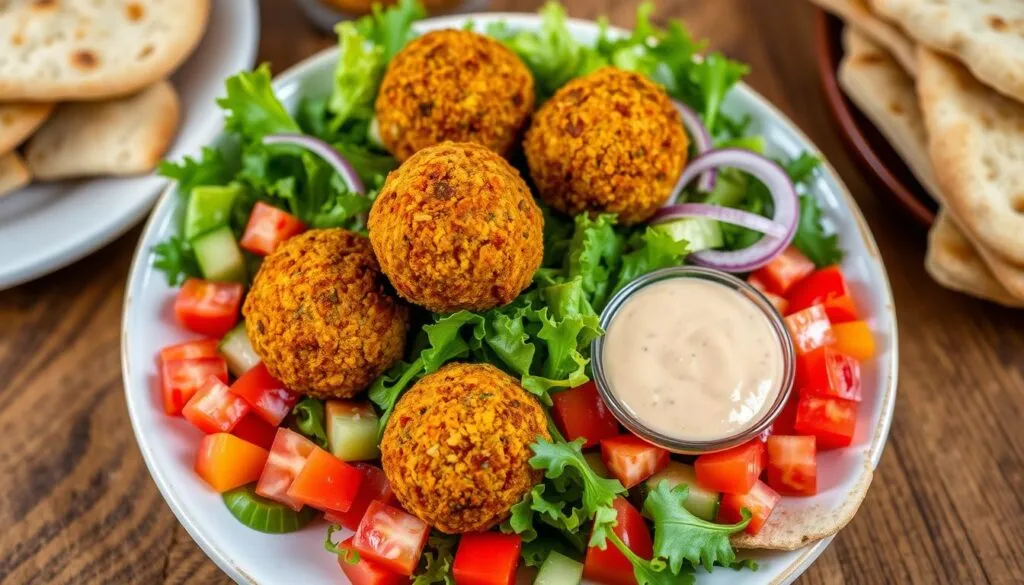Ever wondered why falafel plates are loved by so many? This Middle Eastern dish turns simple ingredients into a feast for the senses. It’s more than just a meal.
The falafel plate is a journey of flavors and traditions. It’s enjoyed from Tel Aviv’s streets to US restaurants. These crispy chickpea balls have won hearts worldwide.
So, what’s the magic of the falafel plate? It’s a mix of protein, spices, and textures that excite your taste buds. It’s perfect for anyone who loves good food, whether you’re a vegetarian or just enjoy tasty meals.
Table of Contents
Key Takeaways
- Falafel plates are packed with nutritional value
- Traditional recipes have over 1,500 years of history
- Each serving offers approximately 5-6 grams of protein
- Versatile dish appealing to vegans and non-vegans alike
- Globally recognized Mediterranean cuisine
Understanding the Rich History of Falafel
The story of the falafel plate is a long journey through time. It started in ancient civilizations and now is loved around the world. This dish has grown from a simple street food to a global favorite.

Falafel’s roots go back to ancient Egypt and the Middle East. It was a nutritious meal for workers and travelers. Traditionally made from fava beans, it was full of protein and complex carbs.
Ancient Culinary Traditions
The Hebrew Bible gives clues about early falafel recipes. It talks about wheat, barley, beans, and lentils. These ingredients show a rich culinary history that led to falafel.
- Originated in ancient Egypt
- Primary ingredients: fava beans and chickpeas
- Nutritionally dense food for laborers
Cultural Evolution
When Jewish immigrants came to Israel in 1948, falafel became more than food. It became a symbol of their culture. It mixed with Palestinian and Mediterranean flavors, becoming diverse and tasty.
“Falafel represents more than a meal; it’s a narrative of cultural memory and culinary innovation.”
Global Popularity
Now, falafel is enjoyed everywhere. You can find it in Tel Aviv street vendors and New York restaurants. Its journey shows its universal appeal and adaptability.
Falafel is still changing, with new cooking methods like baking and air frying. It’s not only tasty but also healthier now.
What Makes Traditional Falafel So Special

Exploring falafel opens a door to its culinary magic. A traditional falafel plate is more than food. It’s a celebration of cooking traditions passed down through generations.
The key to a great falafel plate is in its ingredients and how it’s made. Dried chickpeas are essential, offering a unique cooking experience. Unlike canned chickpeas, dried ones need soaking for 24 hours. This makes them double in size and gain a rich, authentic texture.
- Use only dried chickpeas for authentic flavor
- Soak chickpeas for 24 hours before preparation
- Incorporate fresh herbs for distinctive taste
- Maintain precise frying temperature at 375°F
Making perfect falafel requires attention to detail. The chickpea mixture should resemble coarse sand after processing. This ensures a light, crispy exterior when fried. Chefs suggest adding 1 teaspoon of baking powder for a fluffy interior.
“Falafel is not just a dish, it’s a culinary art form that connects generations through flavor and tradition.”
Spices are the heart of a great falafel plate. Ground cumin, coriander, and a bit of cayenne pepper add depth to the flavor. About 7-8 garlic cloves can make your falafel truly special.
The Essential Components of a Perfect Falafel Plate
Making a perfect falafel plate is an art. It’s more than just food; it’s a mix of textures, flavors, and Mediterranean ingredients. It’s a culinary journey that delights your senses.
Crispy Falafel Balls: The Star of the Plate
The heart of a falafel plate is the crispy falafel balls. These golden balls are made from chickpeas, herbs, and spices. They have a crunchy outside and a soft, tasty inside.
- Perfectly formed spheres with a golden-brown color
- Crisp exterior with a tender inside
- Seasoned with traditional Middle Eastern spices
Fresh Accompaniments That Elevate the Plate
Fresh vegetables are key to a balanced falafel plate. They add crunch, nutrition, and color, making the dish look great.
| Vegetable | Nutritional Benefit |
|---|---|
| Chopped Tomatoes | High in Vitamin C |
| Cucumber | Hydrating and Low Calorie |
| Red Onions | Rich in Antioxidants |
| Lettuce | Adds Crispness |
Traditional Sauces That Complete the Experience
No falafel plate is complete without its signature sauces. Tahini sauce, with its creamy texture and nutty flavor, is a classic choice. It brings everything together.
“A great sauce can transform a good falafel plate into an extraordinary culinary journey.”
By choosing each component carefully, you’ll make a falafel plate that celebrates Mediterranean cuisine. It’s not just a meal; it’s a feast for the senses.
Nutritional Benefits of Mediterranean Falafel
Your falafel plate is more than a tasty meal. It’s a nutritional powerhouse that boosts your health. It combines chickpea falafel, fresh veggies, and traditional sides for a balanced meal.
Let’s dive into the amazing nutrients in a typical falafel plate:
- Protein-Rich Goodness: Falafel offers 8-12 grams of protein per serving. It’s a great plant-based protein choice.
- Calorie-Conscious Option: A serving has 300-400 calories, depending on how it’s made.
- Fiber Boost: It’s full of dietary fiber from chickpeas and whole grains.
“Your falafel plate is not just a meal, it’s a nutritional investment in your health.” – Mediterranean Nutrition Experts
The Mediterranean diet, rich in falafel, brings big health benefits. Studies show it can:
- Lower heart disease risk with healthy fats
- Reduce LDL cholesterol
- Lower type 2 diabetes risk by 30-40%
- Possibly cut cancer and Alzheimer’s disease risk by 25%
| Nutritional Component | Quantity per Serving |
|---|---|
| Protein | 8-12 grams |
| Calories | 300-400 |
| Fiber | 3-5 grams |
| Complex Carbohydrates | 20-25 grams |
Opting for a baked falafel plate boosts its health benefits. It cuts down on fat. Your choice supports both taste and long-term health.
The Art of Creating Authentic Falafel
Making the perfect falafel plate is all about skill, passion, and detail. It’s not just a recipe. It’s a culinary art that turns simple ingredients into a tasty Mediterranean treat.
Selecting Premium Ingredients
Your falafel plate begins with top-notch ingredients. The best falafel comes from dried chickpeas, not canned ones. Here are the key ingredients for a real falafel experience:
- 8 ounces (225g) dried chickpeas
- 5-6 green onions
- 4 medium garlic cloves
- 2 cups fresh herbs (cilantro, parsley, mint)
Precise Preparation Techniques
Preparing falafel needs patience and precision. Soak your dried chickpeas overnight. They’ll grow to the right size for your falafel plate.
| Preparation Step | Details |
|---|---|
| Chickpea Soaking | Minimum 12 hours, no cooking beforehand |
| Refrigeration Time | 30-60 minutes before forming balls |
| Herb Quantity | 2 cups (55g) packed fresh herbs |
Cooking Methods for Perfect Falafel
You can cook your falafel in different ways. Deep-frying gives a crispy outside, but baking is healthier.
- Deep-Frying: 180°C (350°F) for 2-3 minutes
- Baking: 200°C (400°F) for 25-30 minutes
- Pan-Frying: 4-5 minutes until golden brown
“The secret to great falafel is in the details—from ingredient selection to cooking technique.” – Mediterranean Culinary Expert
Popular Falafel Plate Variations
Your falafel plate can turn from a simple meal to a culinary adventure. It can be enjoyed in many ways, from traditional to modern styles. This beloved Mediterranean dish offers exciting ways to enjoy it.
Here are some tasty falafel plate variations for different tastes and dining preferences:
- Classic Pita Pocket Style: Stuffed with crispy falafel balls, fresh veggies, and creamy sauces
- Mezze Platter Presentation: Arranged with multiple small dishes and accompaniments
- Salad Bowl Approach: Falafel served atop fresh greens with vibrant Mediterranean ingredients
- Burger-Inspired Sandwich: Falafel patties nestled between artisan bread
Each falafel plate variation has its own nutritional benefits. A typical serving has about 433 kcal. It also has 18 grams of protein per falafel ball. The average plate has 12 falafel patties, making it a filling meal.
“The beauty of the falafel plate lies in its incredible versatility!” – Mediterranean Cuisine Expert
When making your falafel plate, mix different serving styles to keep meals exciting. You can go from traditional to modern styles. This way, you can create a personalized dining experience that fits your taste and nutritional needs.
Pro tip: Try adding different accompaniments like hummus (¼ cup), fresh spinach (2 cups), and a mix of chopped veggies. This will boost your falafel plate’s flavor and nutritional value.
Essential Sauces and Accompaniments
Creating the perfect falafel plate is more than just the chickpea fritters. The right sauces and sides can make your meal amazing. Let’s dive into the tasty world of falafel plate enhancements that will take your meal to the next level.
Classic Tahini Sauce: The Creamy Cornerstone
Tahini sauce is the heart of a real falafel plate. It’s made from ground sesame seeds and adds a creamy, nutty flavor. This sauce perfectly matches the crispy falafel. Here’s what you need:
- ½ cup tahini
- ¼ cup lemon juice
- 2 garlic cloves
- Salt to taste
Mediterranean Sides That Shine
These traditional Mediterranean sides turn your falafel plate into a feast:
| Side Dish | Flavor Profile | Typical Ingredients |
|---|---|---|
| Hummus | Creamy, Smooth | Chickpeas, Tahini, Olive Oil |
| Baba Ganoush | Smoky, Rich | Roasted Eggplant, Tahini |
| Tabbouleh | Fresh, Herbaceous | Parsley, Tomatoes, Bulgur |
Herb Combinations That Elevate Flavor
Fresh herbs are key to a real falafel plate. A classic mix includes:
- ¼ cup fresh mint leaves
- ¾ cup flat-leaf parsley
- ½ cup cilantro
“The right herbs can transform a simple falafel plate into a culinary masterpiece.” – Mediterranean Cuisine Expert
When putting together your falafel plate, remember to balance everything. Each part should work well together, making for a great meal.
Serving Suggestions and Presentation Tips
Making a stunning falafel plate is an art that blends taste, texture, and looks. Your presentation can turn a basic meal into a feast that pleases all senses.
- Choose a large, flat white or earth-toned plate to highlight colors
- Place falafel balls in a circle
- Add height with strategic placement
- Include bright accompaniments
Enhance your falafel plate with thoughtful garnishes and sides. Professional chefs suggest adding visual and flavor depth with well-chosen elements.
“A great falafel plate tells a story on the plate” – Mediterranean Cuisine Expert
| Presentation Element | Recommended Quantity | Purpose |
|---|---|---|
| Falafel Balls | 3-4 per serving | Primary protein source |
| Hummus Base | 3-4 tablespoons | Creamy foundation |
| Fresh Herbs | Sprinkle generously | Color and freshness |
| Lemon Wedges | 2-3 wedges | Bright, acidic finish |
To truly enjoy the authentic taste, add Mediterranean sides like cucumber salad, pickled veggies, and extra virgin olive oil. Aim to make a falafel plate that’s a feast for the eyes and taste buds.
Why Plant-Based Food Lovers Cherish Falafel
Plant-based food lovers have found a treasure in falafel. It’s a hit among vegetarians and vegans. It’s packed with protein and full of flavor.
Chickpeas are the key to falafel’s nutritional value. They offer about 14.5 grams of protein per cup. This makes them a great choice for those who follow plant-based diets.
“Falafel isn’t just a meal; it’s a celebration of plant-based cuisine!” – Culinary Nutrition Expert
- High protein content from chickpeas
- Naturally vegan ingredients
- Rich in essential nutrients
- Versatile and customizable
The world is seeing a big rise in plant-based food demand. Falafel is leading the way. Restaurants are now offering more vegan options, up by 25%.
| Nutritional Benefit | Value |
|---|---|
| Protein per Serving | 14.5 grams |
| Calories per Serving | 150-200 |
| Cardiovascular Disease Risk Reduction | 30% |
Your falafel plate is more than just a meal. It’s a nutritional powerhouse. Air-frying techniques can cut calories by 30%. This makes it a healthier option for plant-based eaters.
Common Mistakes to Avoid When Making Falafel
Making the perfect falafel plate needs skill and focus. Many people face challenges that can ruin its tasty texture and flavor. This is a beloved dish from the Mediterranean.
To master falafel, you must understand the art of preparation. Let’s look at the main mistakes that can mess up your dish.
Ingredient Selection Pitfalls
- Avoid using canned chickpeas – they have too much water
- Choose dried chickpeas for the real deal
- Soak chickpeas for 12-24 hours to get them right
Processing and Cooking Challenges
The success of your falafel plate depends on how well you prepare it. Knowing common mistakes can improve your cooking.
| Mistake | Consequence | Solution |
|---|---|---|
| Overprocessing mixture | Mushy texture | Pulse ingredients briefly |
| Incorrect oil temperature | Greasy falafel | Maintain 375°F |
| Large falafel balls | Uneven cooking | Form 2-tablespoon sized balls |
“Perfect falafel is an art of precision and patience” – Mediterranean Cooking Experts
For a great falafel plate, use a falafel press for even size. Also, chill the mixture for at least 30 minutes before frying. These steps will give you crispy, golden falafel that will wow anyone.
The Cultural Impact of Falafel in Modern Cuisine
Falafel has grown from a Middle Eastern street food to a global favorite. Its journey shows how food can bring cultures together. Now, your favorite falafel plate is more than a meal—it’s a link between different food cultures.
Falafel’s global popularity shows how food can adapt to new places. Here are some interesting facts:
- Over 30 international cuisines have adopted falafel
- 60% of U.S. food trucks now offer unique falafel dishes
- 25% of Americans look for plant-based meals
*Falafel is more than food—it’s a cultural ambassador that connects communities through shared meals.*
Every region has its own twist on falafel. In India, chefs add garam masala spices. In Mexico, vendors make falafel tacos. Japan’s fine dining places serve falafel with creative sauces, showing its worldwide appeal.
| Region | Unique Falafel Adaptation | Cultural Significance |
|---|---|---|
| India | Spiced with Garam Masala | Vegetarian Culinary Tradition |
| Mexico | Falafel Tacos | Street Food Innovation |
| Japan | Gourmet Presentation | Aesthetic Culinary Expression |
Your falafel plate is a space for global creativity. From street food to fancy restaurants, this simple dish keeps growing. It brings cultures together, one delicious bite at a time.
Conclusion
Exploring the world of falafel plates shows us a dish that’s more than just food. It’s a mix of flavor, health, and tradition. This dish lets you try many variations while keeping its core values of plant-based nutrition.
Falafel plates are great for everyone, from vegans to those looking for healthy meals. They’re made with chickpeas, which are full of protein, fiber, and vitamins. Falafel is now in almost 4% of American restaurants, showing it’s loved everywhere.
Making your own falafel plate is a fun cooking adventure. You can learn how to prepare it, pick the best ingredients, and try different cooking ways. Baking or air frying makes it healthier, with fewer calories and less fat.
In the end, a falafel plate is a celebration of culture, nutrition, and creativity in cooking. So, dive into the world of falafel and see why it’s loved by food enthusiasts everywhere.
Frequently Asked Questions (FAQs)
What is falafel made of?
Falafel is made mostly from chickpeas or fava beans. First, the beans are soaked and ground. Then, they’re mixed with herbs like parsley and spices like cumin. Finally, the mixture is shaped into balls and fried. The result? Crispy, golden falafel that’s perfect for a falafel plate!
How do you eat falafel plate?
Eating a falafel plate is super fun! First, grab some pita bread. Next, add falafel, hummus, and veggies like tomatoes and cucumbers. Then, drizzle tahini sauce on top. You can also mix everything together for a big, tasty bite. It’s like building your own food masterpiece!
Is falafel plate healthy?
Yes, a falafel plate can be healthy! Falafel is packed with plant-based protein and fiber. Also, the veggies and hummus add extra nutrients. Just watch the frying part—baked falafel is a lighter option. Overall, it’s a filling and nutritious meal you’ll feel good about eating!
How is falafel traditionally served?
Traditionally, falafel is served in a pita or on a plate. First, it’s paired with hummus and tahini sauce. Next, fresh veggies like lettuce and tomatoes are added. Sometimes, pickles or hot sauce are included too. A falafel plate is a colorful, flavorful dish you’ll love!
What makes a falafel plate so special?
A falafel plate is special because it’s full of flavors and textures. First, you get the crispy falafel. Then, there’s creamy hummus and fresh veggies. Finally, the tahini sauce ties it all together. It’s like a party on a plate, and you’re invited to enjoy every bite!

